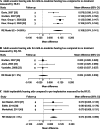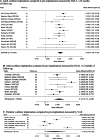The Impact of Hearing Loss and Its Treatment on Health-Related Quality of Life Utility: a Systematic Review with Meta-analysis
- PMID: 36385406
- PMCID: PMC9905346
- DOI: 10.1007/s11606-022-07795-9
The Impact of Hearing Loss and Its Treatment on Health-Related Quality of Life Utility: a Systematic Review with Meta-analysis
Abstract
Background: Hearing loss significantly impacts health-related quality of life (QoL), yet the effects of current treatments on QoL utility remain uncertain. Our objective was to describe the impact of untreated and treated hearing loss on QoL utility to inform hearing healthcare policy.
Methods: We searched databases for articles published through 02/01/2021. Two independent reviewers screened for articles that reported elicitation of general QoL utility values for untreated and treated hearing loss health states. We extracted data and quality indicators from 62 studies that met the inclusion criteria.
Results: Included studies predominately used observational pre/post designs (61%), evaluated unilateral cochlear implantation (65%), administered the Health Utilities Index 3 (HUI3; 71%), and were conducted in Europe and North America (84%). In general, treatment of hearing loss improved post-treatment QoL utility when measured by most methods except the Euro-QoL 5 dimension (EQ-5D). In meta-analysis, hearing aids for adult mild-to-moderate hearing loss compared to no treatment significantly improved HUI3-estimated QoL utility (3 studies; mean change=0.11; 95% confidence interval (CI): 0.07 to 0.14) but did not impact EQ-5D-estimated QoL (3 studies; mean change=0.0; 95% CI: -0.03 to 0.04). Cochlear implants improved adult QoL utility 1-year post-implantation when measured by the HUI3 (7 studies; mean change=0.17; 95% CI: 0.11 to 0.23); however, pediatric VAS-estimated QoL utility was non-significant (4 studies; mean change=0.12; 95% CI: -0.02 to 0.25). The quality of included studies was limited by failure to report missingness of data and low survey response rates. Our study was limited by heterogeneous study populations and designs.
Findings: Treatment of hearing loss significantly improves QoL utility, and the HUI3 and VAS were most sensitive to improvements in hearing. Improved access to hearing healthcare should be prioritized. SYSTEMATIC REVIEW REGISTRATION: PROSPERO: CRD42021253314.
Keywords: cochlear implant; health state utility values; hearing aid; hearing loss; systematic review.
© 2022. The Author(s), under exclusive licence to Society of General Internal Medicine.
Conflict of interest statement
SDE reports an honorarium from HearX for speaking on Viewpoint. All other authors have no conflicts of interest related to this work.
Figures



Similar articles
-
Improving quality of life in the elderly: hearing loss treatment with cochlear implants.BMC Geriatr. 2024 Jan 4;24(1):16. doi: 10.1186/s12877-023-04642-2. BMC Geriatr. 2024. PMID: 38178036 Free PMC article.
-
Agreement between health utility instruments in cochlear implantation.Clin Otolaryngol. 2016 Dec;41(6):737-743. doi: 10.1111/coa.12626. Epub 2016 Feb 12. Clin Otolaryngol. 2016. PMID: 26868059
-
Development and Critical Evaluation of a Condition-Specific Preference-Based Measure Sensitive to Binaural Hearing in Adults: The York Binaural Hearing-Related Quality-of-Life System.Ear Hear. 2022 Mar/Apr;43(2):379-397. doi: 10.1097/AUD.0000000000001101. Ear Hear. 2022. PMID: 34432671
-
Systematic Review of Quality of Life Assessments after Cochlear Implantation in Older Adults.Audiol Neurootol. 2021;26(2):61-75. doi: 10.1159/000508433. Epub 2020 Jul 10. Audiol Neurootol. 2021. PMID: 32653882
-
Association of Bone Conduction Devices for Single-Sided Sensorineural Deafness With Quality of Life: A Systematic Review and Meta-analysis.JAMA Otolaryngol Head Neck Surg. 2022 Jan 1;148(1):35-42. doi: 10.1001/jamaoto.2021.2769. JAMA Otolaryngol Head Neck Surg. 2022. PMID: 34647990 Free PMC article.
Cited by
-
Self-Reported Hearing Aid Use in Russian Adults According to a National Survey.Audiol Res. 2023 Sep 18;13(5):710-720. doi: 10.3390/audiolres13050062. Audiol Res. 2023. PMID: 37736943 Free PMC article.
-
Potential Clinical and Economic Outcomes of Over-the-Counter Hearing Aids in the US.JAMA Otolaryngol Head Neck Surg. 2023 Jul 1;149(7):607-614. doi: 10.1001/jamaoto.2023.0949. JAMA Otolaryngol Head Neck Surg. 2023. PMID: 37200042 Free PMC article.
-
Biomaterial-based drug delivery systems in the treatment of inner ear disorders.J Nanobiotechnology. 2025 Apr 17;23(1):297. doi: 10.1186/s12951-025-03368-0. J Nanobiotechnology. 2025. PMID: 40247337 Free PMC article. Review.
-
Access to Cochlear Implantation: Trends in Surgeon Volume and Training.Laryngoscope. 2025 Jun;135(6):2146-2153. doi: 10.1002/lary.32037. Epub 2025 Feb 11. Laryngoscope. 2025. PMID: 39932075 Free PMC article.
-
Model-Projected Cost-Effectiveness of Adult Hearing Screening in the USA.J Gen Intern Med. 2023 Mar;38(4):978-985. doi: 10.1007/s11606-022-07735-7. Epub 2022 Aug 5. J Gen Intern Med. 2023. PMID: 35931909 Free PMC article.
References
-
- World Health Organization. World Report on Hearing. 2021. Accessed 11 October 2021 at https://www.who.int/teams/noncommunicable-diseases/sensory-functions-dis....
-
- Wilson BS, Tucci DL, Merson MH, O'Donoghue GM. Global hearing health care: new findings and perspectives. Lancet 2017; 390(10111): 2503-15. - PubMed
-
- Yueh B, Collins MP, Souza PE, et al. Long-term effectiveness of screening for hearing loss: the screening for auditory impairment--which hearing assessment test (SAI-WHAT) randomized trial. J Am Geriatr Soc. 2010; 58(3): 427-34. - PubMed
-
- Zoratti MJ, Pickard AS, Stalmeier PFM, Ollendorf D, Lloyd A, Chan KKW, Husereau D, Brazier JE, Krahn M, Levine M, Thabane L, Xie F; Health Utility Book (HUB) Working Group. Evaluating the conduct and application of health utility studies: a review of critical appraisal tools and reporting checklists. Eur J Health Econ. 2021; 22(5): 723-33. 10.1007/s10198-021-01286-0. - PubMed
Publication types
MeSH terms
Grants and funding
LinkOut - more resources
Full Text Sources
Medical
Miscellaneous

